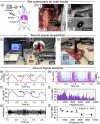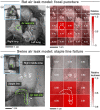Sound-guided assessment and localization of pulmonary air leak
- PMID: 36684064
- PMCID: PMC9842055
- DOI: 10.1002/btm2.10322
Sound-guided assessment and localization of pulmonary air leak
Abstract
Pulmonary air leak is the most common complication of lung surgery, with air leaks that persist longer than 5 days representing a major source of post-surgery morbidity. Clinical management of air leaks is challenging due to limited methods to precisely locate and assess leaks. Here, we present a sound-guided methodology that enables rapid quantitative assessment and precise localization of air leaks by analyzing the distinct sounds generated as the air escapes through defective lung tissue. Air leaks often present after lung surgery due to loss of tissue integrity at or near a staple line. Accordingly, we investigated air leak sounds from a focal pleural defect in a rat model and from a staple line failure in a clinically relevant swine model to demonstrate the high sensitivity and translational potential of this approach. In rat and swine models of free-flowing air leak under positive pressure ventilation with intrapleural microphone 1 cm from the lung surface, we identified that: (a) pulmonary air leaks generate sounds that contain distinct harmonic series, (b) acoustic characteristics of air leak sounds can be used to classify leak severity, and (c) precise location of the air leak can be determined with high resolution (within 1 cm) by mapping the sound loudness level across the lung surface. Our findings suggest that sound-guided assessment and localization of pulmonary air leaks could serve as a diagnostic tool to inform air leak detection and treatment strategies during video-assisted thoracoscopic surgery (VATS) or thoracotomy procedures.
Keywords: Lung disease; digital medicine; lung volume reduction surgery; minimally‐invasive diagnosis; sound analysis.
© 2022 The Authors. Bioengineering & Translational Medicine published by Wiley Periodicals LLC on behalf of American Institute of Chemical Engineers.
Conflict of interest statement
No competing interests to disclose.
Figures




Similar articles
-
[Standard technical specifications for methacholine chloride (Methacholine) bronchial challenge test (2023)].Zhonghua Jie He He Hu Xi Za Zhi. 2024 Feb 12;47(2):101-119. doi: 10.3760/cma.j.cn112147-20231019-00247. Zhonghua Jie He He Hu Xi Za Zhi. 2024. PMID: 38309959 Chinese.
-
Preclinical quantification of air leaks in a physiologic lung model: effects of ventilation modality and staple design.Med Devices (Auckl). 2018 Dec 14;11:433-442. doi: 10.2147/MDER.S184851. eCollection 2018. Med Devices (Auckl). 2018. PMID: 30588134 Free PMC article.
-
[Application of Digital Drainage System in Postoperative Refractory Prolonged Air Leaks after Pulmonary Surgery].Zhongguo Fei Ai Za Zhi. 2017 Dec 20;20(12):833-836. doi: 10.3779/j.issn.1009-3419.2017.12.07. Zhongguo Fei Ai Za Zhi. 2017. PMID: 29277182 Free PMC article. Chinese.
-
The role of new staplers in reducing the incidence of air leak.J Thorac Dis. 2023 Feb 28;15(2):893-900. doi: 10.21037/jtd-22-192. Epub 2022 Aug 19. J Thorac Dis. 2023. PMID: 36910065 Free PMC article. Review.
-
Pressure-dependent persistent air leak in a patient with secondary spontaneous pneumothorax.Am J Med Sci. 2022 Dec;364(6):782-788. doi: 10.1016/j.amjms.2022.06.013. Epub 2022 Jul 2. Am J Med Sci. 2022. PMID: 35787363 Review.
Cited by
-
Lung-Mimetic Hydrofoam Sealant to Treat Pulmonary Air Leak.Adv Healthc Mater. 2024 May;13(13):e2303026. doi: 10.1002/adhm.202303026. Epub 2024 Feb 14. Adv Healthc Mater. 2024. PMID: 38279961 Free PMC article.
References
Grants and funding
LinkOut - more resources
Full Text Sources
Other Literature Sources

